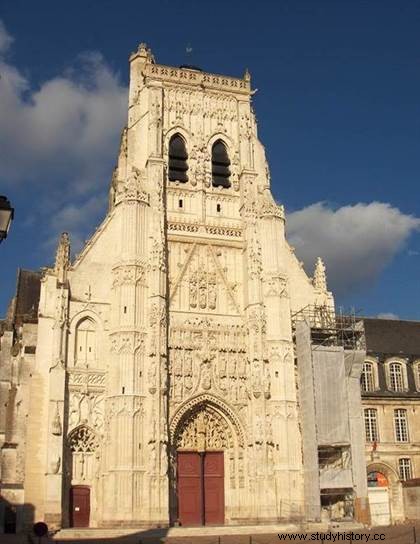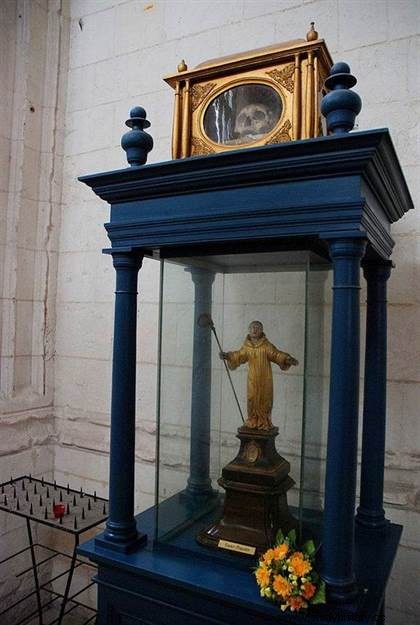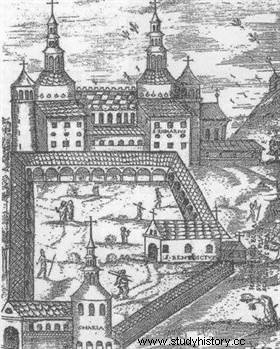 Saint-Riquier Abbey was founded in 625, during the reign of Dagobert I (602, †639) by Richarius, son of the governor of the city of Centula (Saint-Riquier), converted to Christianity by the Welsh monks Caidoc and Fricor. He himself evangelized the north of France before becoming a hermit in the forest of Crécy. He died around 645. The abbey became Benedictine in the middle of the 7th century after following the rule of Saint-Colomban de Luxeuil. However, it was under the reign of Charlemagne (748, †814) that the abbey experienced the peak of its influence, notably under the secular abbeys of Angilbert, then Nithard.
Saint-Riquier Abbey was founded in 625, during the reign of Dagobert I (602, †639) by Richarius, son of the governor of the city of Centula (Saint-Riquier), converted to Christianity by the Welsh monks Caidoc and Fricor. He himself evangelized the north of France before becoming a hermit in the forest of Crécy. He died around 645. The abbey became Benedictine in the middle of the 7th century after following the rule of Saint-Colomban de Luxeuil. However, it was under the reign of Charlemagne (748, †814) that the abbey experienced the peak of its influence, notably under the secular abbeys of Angilbert, then Nithard.
Angilbert, founder of the Abbey of Saint-Riquier

Angilbert (750, †814) is a Frankish aristocrat, Count of Ponthieu, who enters the entourage of Charlemagne as a disciple of Alcuin. A faithful servant of the Emperor, he fulfilled missions as ambassador to Pope Leo III three times and was also responsible for the education of the son of Charlemagne, Pépin, King of Italy. A great scholar, he participated in the work of the Palatine Academy where he was nicknamed Homer. He received the abbey of Saint-Riquier as a reward for his services in 790. Angilbert then undertook to rebuild the abbey in order to make it a model for the time. It is organized around a courtyard surrounded by three churches:the double abbey church of Saint-Sauveur and Saint-Riquier, the church of Saint-Benoît and the church of Sainte-Marie.
Three hundred monks divided into three groups and 99 student monks form the schola. Around the liturgical life is organized a high quality cultural life, from which emerges an important scriptorium. The library has 350 books according to the inventory made in the year 831. Among them, The Gospels of Saint-Riquier, manuscript entirely written in gold letters on purple parchment, offered by Charlemagne to Angilbert.
Witness to Carolingian history
 On the death of Angilbert, it was his son Nithard who became Count of Ponthieu and achieved dignity of the lay abbot of Saint-Riquier. Indeed, Angilbert met within the Palatine Academy, the daughter of Charlemagne, Berthe, of whom he became the lover, then the husband. She gives him two children, Harnit and Nithard. The latter is at the same time a man of war, of government and of culture. Faithful to Louis the Pious (778, †840), then to Charles the Bald (823, †877), he was the instigator of the Oaths of Strasbourg (February 14, 842) of which he probably wrote the texts himself, reported also in his work in 4 volumes, "History of the Sons of Louis the Pious". He also took part in the battle of Fontenoy-en Puisaye in 841 and carried out several diplomatic missions on behalf of Charles the Bald. He died in combat, in 845, in a battle against the Vikings. He was buried in Saint-Riquier alongside his father.
On the death of Angilbert, it was his son Nithard who became Count of Ponthieu and achieved dignity of the lay abbot of Saint-Riquier. Indeed, Angilbert met within the Palatine Academy, the daughter of Charlemagne, Berthe, of whom he became the lover, then the husband. She gives him two children, Harnit and Nithard. The latter is at the same time a man of war, of government and of culture. Faithful to Louis the Pious (778, †840), then to Charles the Bald (823, †877), he was the instigator of the Oaths of Strasbourg (February 14, 842) of which he probably wrote the texts himself, reported also in his work in 4 volumes, "History of the Sons of Louis the Pious". He also took part in the battle of Fontenoy-en Puisaye in 841 and carried out several diplomatic missions on behalf of Charles the Bald. He died in combat, in 845, in a battle against the Vikings. He was buried in Saint-Riquier alongside his father.
The two graves were found under the portal of the abbey church in 1989. As far as Nithard is concerned, the causes of death are visible on the bones discovered:the skull bears traces of a fatal blow. Returned to the city of Saint-Riquier on March 9, 2012, Nithard's remains are presented at the current exhibition, before he is reburied.
The abbey was devastated by the Vikings in 881. The buildings were restored in the 11th century.
Bibliography
- Pierre Riché, The Carolingians, A family that made Europe, Pluriel 2011.
- Jean Favier, Dictionary of Medieval France, Fayard.
- Europe before Europe, The Carolingians, Exhibition Catalogue, June 2014.
